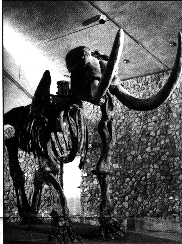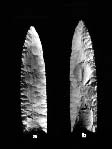Mastodons along the Mississippi
by Pat Middleton
Contents may not be reposted, reproduced or republished in any format without permission of the publisher.
Excerpted from Volume 3 (St. Louis to Memphis), Discover! America's Great River Road by Pat Middleton, click link to purchase all four Volumes of Discover! online.
[ Ice Age Armadillos ] [ The Clovis Connection ] [Glaciers Left Their Mark on the Mississippi]
Click here for press release about a Mastodon skull retrieved from the Mississippi River by the St. Louis District Corps of Engineers.The Kimmswick, Missouri, mastodon bones were first discovered in May of 1839 and described as the Missourium Kochii or the Missouri Leviathan. Dr. Albert C. Koch--part scientist and part showman in the tradition of P. Barnam--supposed it was an entirely new species from the known mammoths and mastodon species at the time and that it was especially adapted to living for great lengths of time under water, similar to a hippopotamus. By 1840, he had amassed enough bones to mount a skeleton which he displayed in his St. Louis Museum (at a site almost beneath the arch) and eventually toured throughout the USA and parts of Europe. The original Kimmswick mastodon bones were purchased by the British Museum in London.
An account in Centennial, by James A. Michener, relates a visit by Levi and Elly Zendt to "see the Gigantic Elephant Discovered in These Regions by Dr. Albert Koch. . .". when they passed through St. Louis on their way west in 1844. The Zendts, like most other immigrants in the western expansion, had never seen an animal so fearsome as the skeleton suggested.
The phrase "seeing the elephant" as in "I saw the elephant" symbolized the amazing new world of America's west. It also referred to the great awe, fear, terror the pioneers faced when making the trip west. "When a man saw the elephant, . . .rising out of the darkness with those beady, flaming eyes, he must heed its warning" to go no further. Many of those who passed Koch's museum on Market Street "saw the elephant" both literally and figuratively! (Centennial, p. 402)
Fossil records indicate that there have been five families of elephant-like mammals (the Proboscidea)
with as many as 100 different species during the 40-million-year history of this order. Today only two species of two genera still survive, the African and Asian elephants. In 1979, it is estimated that there were 1.5 million elephants in Africa. Today, less than half that number survive. It is estimated that only 100,000 elephants will exist in the present day.
It was 1979 before excavations by the Illinois State Museum Society associated a complete Clovis projectile point (and other stone tools and waste flakes) with the bones and teeth of Mastodon and other fauna in the Kimmswick Bone Beds. This was significant because it provided definitive evidence for the association of the American mastodon and the Clovis spearpoint.
The Clovis artifacts found at the Kimmswick site indicate that it was not only a site for killing and butchering of mastodons, but that chipped-stone weapons were manufactured at the site. The area was likely a deciduous woodland with open grassy meadows with limited occupation by the Clovis hunters.
The Clovis people are considered to be earliest successful group of Native Americans. Their culture is most similar to those found at the time in northeast Asia. It is believed they migrated to North America nearly 12,000 years ago via the Bering Straits, a 1300-mile-wide land bridge to NA.
Artifacts date from 11,300 to 10,900 years ago, from coast to coast. However, Clovis/mammoth remains occur only in from Arizona, New Mex and Texas north to S Dakota. 1933 first artifacts found w/mammoth bones in Clovis, New Mexico . Less than 15 sites are in assoc with mammoth bones, all on the western plains. Clovis/mastodon site is only here at Kimmswick Bone Beds.
It is believed that the Clovis people were nomadic, living in groups of about 50 men, women and children. They were expert artisans and skilled big-game hunters. They lived successfully among such large ice age animals as mammoth and mastodons, camels, llamas, horses, peccaries, stag-moose, musk-oxen, saber-tooth cats, bears, lions, cheetahs, dire wolves. The closest similar environment today are the savannas of Africa. All these large animals became extinct by the end of the ice age.
ARMADILLOS in MISSOURI??
Should you see an armadillo in Missouri or Illinois, please report your observation to Russell Graham at the research and Collections Center, Illinois State Museum, 1011 East Ash, Springfield, IL 62703, or call 217-785-4844. You will add to researchers' understanding of why, how, and when armadillos expand or contract their ranges. Tell him you saw this notice on the internet.
Among other large animal bones found in rock beds and caves in the area of Mastodon State Historic Site are the remains of the extinct Beautiful Armadillo. This is of special interest to researchers in the Illinois & Missouri area as there are signs that the modern-day Nine-banded Armadillo may be expanding its range to include southern Illinois and Missouri. In 1993 the first confirmed spotting of an armadillo was made near Hillsboro, about 30 miles south of St. Louis.
Scientists today are studying with great interest the northerly expansion of the Armadillo from the Rio Grade River Valley in southern Texas at the beginning of the 20th century. Is the modern-day armadillo invading new territory as winters become less severe or simply returning to an area previously inhabited by the species. (While the climate then was much colder than it is today, it may not have been as extreme in the winter as ours is.)
The Ice-Age armadillo was identical to the modern-day armadillo except that it was two to three times larger. Its bones, teeth and bits of shell have been found in deposits that are over 40,000 years old. Scientist were surprised to find its fossils ranging throughout most of southwestern Iowa, central Missouri, and southern Indiana almost identical to where modern-day armadillos have been spotted.
More Web info on Mammoths and Mastodons!
- A site about prehistoric elephants, mammoths, mastodons, and more!
- Pleistocene Epoch Everything you ever wanted to know about the Pleistocene age! Nice site, courtesy of the St. Louis Science Center.
- Smithsonian Page on Early Americans
- Clovis Hunters from the National Park Service. Nice details.
- Description of Mastodons
- Description of Mammoths
- Smithsonian pictures of Mastodon and Mammoth teeth compared.
- Map of Mastodon Finds in the Midwestern US
Looking for more? SEARCH NOW!
 Custom Search
Custom SearchCredits:
[Info from a Clovis-Mastodon Association in Eastern Missouri, SCIENCE, 4 September 1981, Vol 213, pp. 1115-1117]
[info from Seeing the Elephant by Jeffrey J. Saunders, Assoc. Curator of Geology, Illinois State Museum. The Living Museum, Vol. 51, No. 3]
[Mastodon info and photos from Russell Graham, Illinois State Museum, from information published in The Living Museum.]
[Armadillo drawing by Julianne Snider for the Illinois State Museum]





